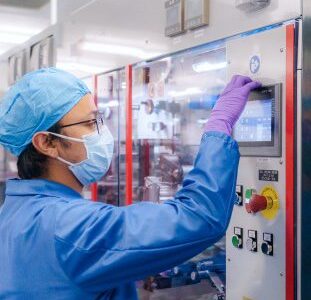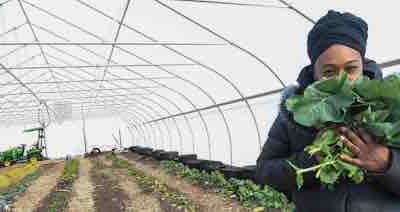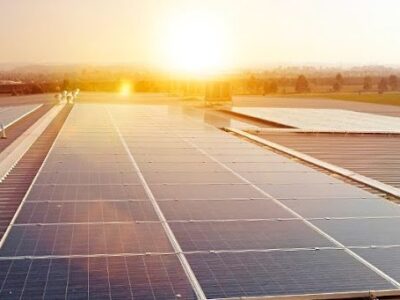(Bloomberg) —
During the coronavirus lockdown, the light at the end of the tunnel for my family was reflected from the rooftop of our old Austrian farmhouse.
For those sixlong weeks, a record run of clear, cool, and sun-soaked days helped us cope with the litany of dark news that upended global markets at the height of Covid-19. Working alongside our solar panels showed how an investment in renewable energy might yet make our home economics stronger on the other side of the pandemic.
It wasn’t clear we’d invest in solar back when we bought the place. The 230-year-old stone cottage was originally designed as a bolthole for itinerant lumberjacks sent to harvest timber in Austria’s Waldviertel, an hour northwest of Vienna. By the time we arrived in 2012, there were more immediate energy upgrades that made sense.
“Panels tell more about the politics in the home than they do about its power,” the owner gruffly told us before we passed papers. And for years we followed his advice to invest in making the house more energy-efficient—replacing windows with double-paned glass, insulating the attic, installing a heat pump and infrared electric panels to back up high-efficiency wood stoves. There wasn’t a lot of moneyleft over to put into glitzy photovoltaics.
But a couple of important new facts changed our calculations over the years. One was our family’s sensitivity, particularly that of my 15-year-old son, to the science of climate change. The other was that the economics of solar became much more attractive.
During long walks in the surrounding woods, we discussed how a warmer planet changes the way that carbon cycles between the atmosphere, vegetation, and oceans. Our son’s alarm over climate change grew over the years as he witnessed the effects of ever milder winters and drier summers on the local ecology—which was already threatening to destroy our region’s traditional timber industry.
Even though Austria generates some 80% of its electricity with renewables, mostly hydropower, it’s become clearer that the country needs many more solar panels and windmills to reduce industrial emissions from aluminum, steel, and brick manufacturers. To meet its climate goals, the state-run utility, Verbund AG, figures Austria needs to install new clean sources equivalent to twice the volume of electricity currently generated by all the turbines churning on Austria’s stretch of the Danube River.
And then there was the important issue of cost. Solar prices fell more than 75%in the eight years since we bought the house. The manufacturing cost to make commonly used panels generate a watt of power was 85¢ in 2012, according to BloombergNEF. That figure fell to about 21¢ by this year.
We finally took the plunge in 2018 after determining that investing in solar was a safe and responsible use of cash otherwise languishing in our zero-interest savings account. The lure of eventually supplying our own fuel for an electric car, which would dramatically shorten the payback timeline, also influenced our decision.
Austria subsidized our roughly €12,000 ($13,463) solar investment to the tune of about €1,500 at the end of 2018. We also bought a 5-kilowatt battery that stores the equivalent of one hour of sunshine—enough to get us through a single night of cooking dinner and watching TV, with enough juice left over to brew coffee in the morning. The national electricity grid contracted to pay us a bit more than 5¢ for each extra kilowatt-hour we produce but can’t consume. It installed a digital meter that accounts for the power our home uses, and we sell the excess back to the grid.
On the eve of March 12, when Covid-19 forced everyone in Austria to shelter at home, we’d been producing and consuming solar energy for about a year, with mixed results. It took longer than it should have for the utility to process our paperwork, resulting in several months of wasted generation. Then there was the learning curve in figuring out the clunky apps that control the battery and panels. We figured we were on the long end of the 9- to 10-year investment payback on a system expected to operate at least two decades.
At the end of the first year we still had to buy about 30% of our electricity from the grid, but we were able to offset that cost (and make a small profit) by generating €800 of power and selling the excess on sunny days.
We might have continued that middling solar experience were it not for being forced to spend more time at home with our panels. As the pandemic lockdown dragged on from days into weeks and then months, our family began noticing how slight modifications to our daily routine increased the return on the power we generated. Paying closer attention to how we use electricity became a game to pass the humdrum days of quarantine.
Our son used the digital apps connecting our panels with the battery to calculate the baseline power needed to keep our freezers, computers, and networks humming in the background: a measly 250 watts — equivalent to four lightbulbs. We began noticing the unique power fingerprints that distinguished the use of a hairdryer from a vacuum cleaner or blender and began doing the wash on sunny afternoons to consume more of our own electricity.
That experience jibes with research showing that merely giving consumers convenient real-time insight into their power usage can reduce electricity demand by as much as a fifth. An experiment run by Siemens AG in Vienna found that apartments kitted out with digital monitors used 10% less power. By the time April rolled around, longer daylight hours and more efficient power use meant we needed to tap the national grid only for every 1/10th watt we couldn’t produce when the sun wasn’t shining or our battery was empty.
And then something remarkable happened. During the darkest days of the pandemic, as the virus spread and sent economies into a tailspin, our panels began yielding record returns.
Anecdotal observations about our pristine spate of spring weather turned into data-driven analysis of solar performance. Even as the power markets swooned as the virus spread, the payments we earned from generating power remained stable. We collected the same 5¢ per kilowatt-hour of excess energy produced, even as power demand shrank and markets dived. In April we earned an average €5 a day while consuming all the electricity we needed. Just as oil prices were turning negative, I noted that we earned our first €1,000 from solar generation. Clearly ours was a return that would never make us rich, but it was shielded by the gyration of commodity markets.
The national weather service reported on April 22 that our region in Austria had received about 20% more spring sun compared with historical norms, resulting in apple trees blooming a week earlier than normal. Solar-power generation records fell across Germany as the combination of sunny, cool, and breezy conditions maximized output from rooftop arrays that had grown to cover 20 square kilometers (7.7 square miles) more area compared with the year before. At my home we finished the month generating a record 906kWh of power, 25% more than during the same month the year before coronavirus.
“April is often when you hit a new seasonal record, but this year was extraordinary,” said BNEF solar analyst Jenny Chase. She suggested that lockdown effects resulting in less air pollution and fewer jet contrails also boosted the solar return.
One stellar month of exceptional yield probably doesn’t change the timeline on our solar return on investment. Our neighbors in the countryside, mostly small farmers, many of whom have also been installing panels, are desperate for more rainy days to irrigate their crops. A return to the mean, even one slightly adjusted for global warming, is desirable.
Even though our experiment with solar power is just getting started, in a time of great human tragedy, our panels help us feel a little more hopeful about the world around us. Renewable energy gives us a glimpse of what’s possible.
To contact the author of this story:
Jonathan Tirone in Vienna at jtirone@bloomberg.net





